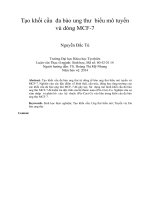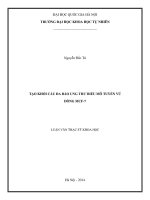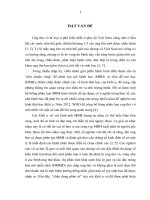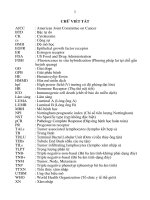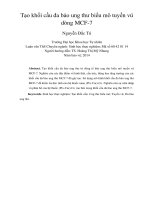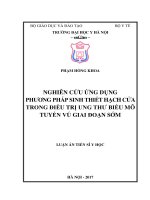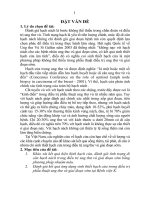Tạo khối cầu đa bào ung thư biểu mô tuyến vú dòng MCF-7 tt
Bạn đang xem bản rút gọn của tài liệu. Xem và tải ngay bản đầy đủ của tài liệu tại đây (787.92 KB, 10 trang )
Tạo khối cầu đa bào ung thư biểu mô tuyến
vú dòng MCF-7
Nguyễn Đắc Tú
Trường Đại học Khoa học Tự nhiên
Luận văn Thạc sĩ ngành: Sinh học; Mã số: 60 42 01 14
Người hướng dẫn: TS. Hoàng Thị Mỹ Nhung
Năm bảo vệ: 2014
Abstract. Tạo khối cầu đa bào ung thư từ dòng tế bào ung thư biểu mô tuyến vú
MCF-7. Nghiên cứu các đặc điểm về hình thái, cấu trúc, động học tăng trưởng của
các khối cầu đa bào ung thư MCF-7 đã gây tạo. Sử dụng mô hình khối cầu đa bào
ung thư MCF-7 để kiểm tra độc tính của hệ thuốc nano (Ptx-Cur)-Co. Nghiên cứu sự
xâm nhập và phân bố của hệ thuốc (Ptx-Cur)-Co vào bên trong khối cầu đa bào
ung thư MCF-7.
Keywords. Sinh học thực nghiệm; Tạo khối cầu; Ung thư biểu mô; Tuyến vú; Đa
bào ung thư
Content
Luận văn cao học
Nguyễn Đắc Tú K20 - Sinh học thực nghiệm
i
MỤC LỤC
DANH MỤC HÌNH
DANH MỤC BẢNG
DANH MỤC CHỮ VIẾT TẮT
MỞ ĐẦU 1
1.TỔNG QUAN 3
1.1.Sàng lọc thuốc 3
1.1.1.Quy trình sàng lọc thuốc 3
1.1.2.Các mô hình sàng lọc thuốc tiền lâm sàng 5
1.2.Mô hình nuôi cấy khối cầu đa bào ung thư 11
1.2.1.Nuôi cấy ba chiều (3D) 11
1.2.2.Mô hình nuôi cấy khối cầu đa bào ung thư 13
1.2.3.Các vấn đề kĩ thuật liên quan tới nuôi cấy khối cầu đa bào 19
2.ĐỐI TƯỢNG VÀ PHƯƠNG PHÁP NGHIÊN CỨU 27
2.1.Đối tượng nghiên cứu 27
2.1.1.Dòng tế bào ung thư vú MCF-7 27
2.1.2.Hệ thuốc nano 28
2.1.3.Máy móc thiết bị và vật tư tiêu hao 28
2.2.Phương pháp nghiên cứu 31
2.2.1.Hoạt hóa và nhân nuôi tế bào 31
2.2.2.Gây tạo khối cầu đa bào ung thư 31
2.2.3.Nghiên cứu động học sinh trưởng của khối cầu đa bào ung thư 33
2.2.4.Thử độc tính 34
2.2.5.Nghiên cứu khả năng xâm nhập của thuốc vào mô hình khối cầu đa bào 39
Luận văn cao học
Nguyễn Đắc Tú K20 - Sinh học thực nghiệm
ii
3.KẾT QUẢ 40
3.1.Hoạt hóa và nhân nuôi dòng tế bào ung thư vú MCF-7 40
3.2.Gây tạo và nghiên cứu động học sinh trưởng của khối cầu đa bào ung thư MCF-7 41
3.2.1.Kết quả tạo khối cầu đa bào ung thư MCF-7 41
3.2.2.Động học và một số đặc điểm sinh trưởng của khối cầu đa bào ung thư MCF-7
45
3.3.Thử nghiệm độc tính của ((Ptx-Cur)-Co 51
3.3.1.Độc tính trên mô hình tế bào MCF-7 nuôi cấy đơn lớp 51
3.3.2.Độc tính trên mô hình khối cầu đa bào ung thư MCF-7 54
3.4.Sự xâm nhập của thuốc vào bên trong khối cầu đa bào ung thư MCF-7 66
4.BÀN LUẬN 69
5.KẾT LUẬN VÀ KIẾN NGHỊ 75
5.1.Kết luận 75
5.2.Kiến nghị 75
TÀI LIỆU THAM KHẢO 76
Luận văn cao học
Nguyễn Đắc Tú K20 - Sinh học thực nghiệm
76
TÀI LIỆU THAM KHẢO
1. Barasoain I, Diaz JF, Andreu JM (2010), Chapter 19 - Fluorescent Taxoid Probes
for Microtubule Research, Academic Press,
2. Bjerkvig R (1992), "Spheroid culture in cancer research". Boca Raton Publisher,
Vol. 1 (p. pp.135-158.
3. Bourrat-Floeck B, Groebe K, Mueller-Klieser W (1991), "Biological response of
multicellular emt6 spheroids to exogenous lactate". International Journal of Cancer, 47
(5), p. 792-799.
4. Chakraborty, B.S. (2001), "7 - Cancer drug development - Key regulatory
considerations". Health Administrator, 20 (p. pp. 29-36.
5. Charafe-Jauffret E, Ginestier C, Monville F, Finetti P, Adelaide J, Cervera N,
Fekairi S, Xerri L, Jacquemier J, Birnbaum D, Bertucci F (2005), "Gene expression
profiling of breast cell lines identifies potential new basal markers". Oncogene, 25 (15),
p. 2273-2284.
6. Chignell CF, Bilskj P, Reszka KJ, Motten AG, Sik RH, Dahl TA (1994), "Spectral
And Photochemical Properties Of Curcumin". Photochemistry and Photobiology, 59 (3),
p. 295-302.
7. Choi H, Chun Y-S, Kim S-W, Kim M-S, Park J-W (2006), "Curcumin Inhibits
Hypoxia-Inducible Factor-1 by Degrading Aryl Hydrocarbon Receptor Nuclear
Translocator: A Mechanism of Tumor Growth Inhibition". Molecular Pharmacology, 70
(5), p. 1664-1671.
8. Choi M-R, Stanton-Maxey KJ, Stanley JK, Levin CS, Bardhan R, Akin D, Badve
S, Sturgis J, Robinson JP, Bashir R, Halas NJ, Clare SE (2007), "A Cellular Trojan Horse
for Delivery of Therapeutic Nanoparticles into Tumors". Nano Letters, 7 (12), p. 3759-
3765.
9. de Ridder L (1997), "Autologous confrontation of brain tumor derived spheroids
with human dermal spheroids". Anticancer research, 17 (6B), p. 4119-4120.
10. Donghui Jing, Lye T. Lock, Tzanakakis ES (2010), "Scalable Stirred-Suspension
Bioreactor Culture of Human Pluripotent Stem Cells ". Tissue Engineering, 16 (2).
Luận văn cao học
Nguyễn Đắc Tú K20 - Sinh học thực nghiệm
77
11. Durand R (1976), "Cell Cycle Kinetics In An In Vitro Tumor Model". Cell
Proliferation, 9 (5), p. 403-412.
12. Freshney, R.I (2005), "Culture of Animal Cells: A Manual of Basic Technique".
Willey Blackwell, 5th edition.
13. Friedrich J, Ebner R, Kunz-Schughart LA (2007), "Experimental anti-tumor
therapy in 3-D: Spheroids – old hat or new challenge?". International Journal of
Radiation Biology, 83 (11-12), p. 849-871.
14. Friedrich J, Eder W, Castaneda J, Doss M, Huber E, Ebner R, Kunz-Schughart LA
(2007), "A Reliable Tool to Determine Cell Viability in Complex 3-D Culture: The Acid
Phosphatase Assay". Journal of Biomolecular Screening, 12 (7), p. 925-937.
15. Friedrich J, Seidel C, Ebner R, Kunz-Schughart LA (2009), "Spheroid-based drug
screen: considerations and practical approach". Nat. Protocols, 4 (3), p. 309-324.
16. Gurski LA, Jha AK, Zhang C, Jia X, Farach-Carson MC (2009), "Hyaluronic acid-
based hydrogels as 3D matrices for in vitro evaluation of chemotherapeutic drugs using
poorly adherent prostate cancer cells". Biomaterials, 30 (30), p. 6076-6085.
17. Hamer Philip C. De W, Jonker A, Leenstra S, Ruijter JM, Noorden CJFV (2005),
"Quantification of Viability in Organotypic Multicellular Spheroids of Human Malignant
Glioma using Lactate Dehydrogenase Activity: A Rapid and Reliable Automated Assay".
Journal of Histochemistry & Cytochemistry, 53 (1), p. 23-34.
18. Haycock JW (2010), "3D Cell Culture: A Review of Current Approaches and
Techniques ". Spinger Protocol, Methods in Molecular Biolog 695 (p. 1-15.
19. Hirschhaeuser F, Menne H, Dittfeld C, West J, Mueller-Klieser W, Kunz-
Schughart LA (2010), "Multicellular tumor spheroids: An underestimated tool is catching
up again". Journal of Biotechnology, 148 (1), p. 3-15.
20. Ho WY, Yeap SK, Ho CL, Rahim RA, Alitheen NB (2012), "Development of
Multicellular Tumor Spheroid (MCTS) Culture from Breast Cancer Cell and a High
Throughput Screening Method Using the MTT Assay". PLoS ONE, 7 (9), p. e44640.
21. Hoai Nam N, Hong Ha Tran T, Duong Le Q, Toan Nguyen T, Nhu Hang Tran T,
Mai Huong L, Phuong Thu H (2012), "Apoptosis induced by paclitaxel-loaded
copolymer PLA–TPGS in Hep-G2 cells". Advances in Natural Sciences: Nanoscience
and Nanotechnology, 3 (4), p. 045005.
Luận văn cao học
Nguyễn Đắc Tú K20 - Sinh học thực nghiệm
78
22. Ivascu A, Kubbies M (2006), "Rapid Generation of Single-Tumor Spheroids for
High-Throughput Cell Function and Toxicity Analysis". Journal of Biomolecular
Screening, 11 (8), p. 922-932.
23. Kavallaris M, Verrills NM, Hill BT (2001), "Anticancer therapy with novel
tubulin-interacting drugs". Drug Resistance Updates, 4 (6), p. 392-401.
24. Kunz-Schughart LA, Freyer JP, Hofstaedter F, Ebner R (2004), "The Use of 3-D
Cultures for High-Throughput Screening: The Multicellular Spheroid Model". Journal of
Biomolecular Screening, 9 (4), p. 273-285.
25. Kunz-Schughart LA, Kreutz M, Knuechel R (1998), "Multicellular spheroids: a
three-dimensional in vitro culture system to study tumour biology". International Journal
of Experimental Pathology, 79 (1), p. 1-23.
26. Landry J, Bernier D, Ouellet C, Goyette R, Marceau N (1985), "Spheroidal
aggregate culture of rat liver cells: histotypic reorganization, biomatrix deposition, and
maintenance of functional activities". The Journal of Cell Biology, 101 (3), p. 914-923.
27. Lee JS, Feijen J (2012), "Biodegradable polymersomes as carriers and release
systems for paclitaxel using Oregon Green® 488 labeled paclitaxel as a model
compound". Journal of Controlled Release, 158 (2), p. 312-318.
28. Lin R-Z, Chang H-Y (2008), "Recent advances in three-dimensional multicellular
spheroid culture for biomedical research". Biotechnology Journal, 3 (9-10), p. 1172-
1184.
29. Lu H-F, Lim WS, Wang J, Tang Z-Q, Zhang P-C, Leong KW, Chia SM, Yu H,
Mao H-Q (2003), "Galactosylated PVDF membrane promotes hepatocyte attachment and
functional maintenance". Biomaterials, 24 (27), p. 4893-4903.
30. Masters, J.R.W., (2002), "Cancer cell lines". Kluwer Academic Publishers, Vol. I,
II, III.
31. Mayer B, Klement G, Kaneko M, Man S, Jothy S, Rak J, Kerbel RS (2001),
"Multicellular gastric cancer spheroids recapitulate growth pattern and differentiation
phenotype of human gastric carcinomas". Gastroenterology, 121 (4), p. 839-852.
32. Minchinton AI, Tannock IF (2006), "Drug penetration in solid tumours". Nat Rev
Cancer, 6 (8), p. 583-592.
Luận văn cao học
Nguyễn Đắc Tú K20 - Sinh học thực nghiệm
79
33. Mu L, Feng SS (2003), "A novel controlled release formulation for the anticancer
drug paclitaxel (Taxol®): PLGA nanoparticles containing vitamin E TPGS". Journal of
Controlled Release, 86 (1), p. 33-48.
34. Nicholson KM, Bibby MC, Phillips RM (1997), "Influence of drug exposure
parameters on the activity of paclitaxel in multicellular spheroids". European Journal of
Cancer, 33 (8), p. 1291-1298.
35. Pampaloni F, Reynaud EG, Stelzer EHK (2007), "The third dimension bridges the
gap between cell culture and live tissue". Nat Rev Mol Cell Biol, 8 (10), p. 839-845.
36. Phung YT, Barbone D, Broaddus VC, Ho aM (2011), "Generation of In Vitro
Multicellular Spheroids for the Study of Monoclonal Antibody Therapy". Journal of
cancer, p.
37. Ross DT, Perou CM (2001), "A comparison of gene expression signatures from
breast tumors and breast tissue derived cell lines". Disease Markers, 17 (2), p. 99-109.
38. Sato T, Katagiri K, Gohbara A, Inoue K, Ogonuki N, Ogura A, Kubota Y, Ogawa
T (2011), "In vitro production of functional sperm in cultured neonatal mouse testes".
Nature, 471 (7339), p. 504-507.
39. Shah N, Jin K, Cruz L-A, Park S, Sadik H, Cho S, Goswami CP, Nakshatri H,
Gupta R, Chang HY, Zhang Z, Cimino-Mathews A, Cope L, Umbricht C, Sukumar S
(2013), "HOXB13 Mediates Tamoxifen Resistance and Invasiveness in Human Breast
Cancer by Suppressing ERα and Inducing IL-6 Expression". Cancer Research, 73 (17), p.
5449-5458.
40. Shi J, Orth JD, Mitchison T (2008), "Cell Type Variation in Responses to
Antimitotic Drugs that Target Microtubules and Kinesin-5". Cancer Research, 68 (9), p.
3269-3276.
41. Smalley KSM, Haass NK, Brafford PA, Lioni M, Flaherty KT, Herlyn M (2006),
"Multiple signaling pathways must be targeted to overcome drug resistance in cell lines
derived from melanoma metastases". Molecular Cancer Therapeutics, 5 (5), p. 1136-
1144.
42. Soule HD, Vazquez J, Long A, Albert S, Brennan M (1973), "A Human Cell Line
From a Pleural Effusion Derived From a Breast Carcinoma". Journal of the National
Cancer Institute, 51 (5), p. 1409-1416.
Luận văn cao học
Nguyễn Đắc Tú K20 - Sinh học thực nghiệm
80
43. Sutherland R, Carlsson J, Durand R, Yuhas J (1981), "Spheroids in Cancer
Research". Cancer Research, 41 (7), p. 2980-2984.
44. Sutherland RM, MacDonald HR, Howell RL (1977), "Multicellular Spheroids: A
New Model Target for In Vitro Studies of Immunity to Solid Tumor Allografts: Brief
Communication". Journal of the National Cancer Institute, 58 (6), p. 1849-1853.
45. Sutherland RM, McCredie JA, Inch WR (1971), "Growth of Multicell Spheroids
in Tissue Culture as a Model of Nodular Carcinomas". Journal of the National Cancer
Institute, 46 (1), p. 113-120.
46. Takezawa T (2003), "A strategy for the development of tissue engineering
scaffolds that regulate cell behavior". Biomaterials, 24 (13), p. 2267-2275.
47. Tammy T. Chang, Hughes-Fulford M (2008), "Monolayer and Spheroid Culture of
Human Liver Hepatocellular Carcinoma Cell Line Cells Demonstrate Distinct Global
Gene Expression Patterns and Functional Phenotypes ". Tissue Engineering, 15 (3), p.
48. Teicher, B.A. (1997), "Anticancer Drug Development Guide". p.
49. Teicher BA (2001), "Tumour Models in Cancer Research, Cancer Drug Discovery
and Deverlopment". ed. B.A. Teicher, Human Press, New Jersey, p.
50. Thu HP, Quang DT, Trang MTT, Ha TTH, Nam NH, Phuc NX, Nguyet TTM,
Thong PQ, Tuyet PTH, Oanh VTK, Huong LM (2013), "In Vitro Apoptosis
Enhancement of Hep-G2 Cells by PLA–TPGS and PLA–PEG Block
Copolymer Encapsulated Curcumin Nanoparticles". Chemistry Letters, 42 (3), p. 255-
257.
51. Tung Y-C, Hsiao AY, Allen SG, Torisawa Y-s, Ho M, Takayama S (2011),
"High-throughput 3D spheroid culture and drug testing using a 384 hanging drop array".
Analyst, 136 (3), p. 473-478.
52. Maltzahn G, Park J-H, Agrawal A, Bandaru NK, Das SK, Sailor MJ, Bhatia SN
(2009), "Computationally Guided Photothermal Tumor Therapy Using Long-Circulating
Gold Nanorod Antennas". Cancer Research, 69 (9), p. 3892-3900.
53. Ward Jp, King Jr (1997), "Mathematical modelling of avascular-tumour growth".
Mathematical Medicine and Biology, 14 (1), p. 39-69.
54. Wartenberg M, Budde P, de Marees M, Grunheck F, Tsang SY, Huang Y, Chen Z-
Y, Hescheler J, Sauer H (0000), "Inhibition of Tumor-Induced Angiogenesis and Matrix-
Luận văn cao học
Nguyễn Đắc Tú K20 - Sinh học thực nghiệm
81
Metalloproteinase Expression in Confrontation Cultures of Embryoid Bodies and Tumor
Spheroids by Plant Ingredients Used in Traditional Chinese Medicine". Lab Invest, 83
(1), p. 87-98.
55. Wartenberg M, Dönmez F, Ling Fc, Acker H, Hescheler J, Sauer H (2001),
"Tumor-induced angiogenesis studied in confrontation cultures of multicellular tumor
spheroids and embryoid bodies grown from pluripotent embryonic stem cells". The
FASEB Journal, 15 (6), p. 995-1005.
56. Wu F-Y, Sun M-Z, Xiang Y-L, Wu Y-M, Tong D-Q (2010), "Curcumin as a
colorimetric and fluorescent chemosensor for selective recognition of fluoride ion".
Journal of Luminescence, 130 (2), p. 304-308.
57. Yen T. Phung, Dario Barbone, V. Courtney Broaddus, Ho1 M (2011), "Rapid
Generation of In Vitro Multicellular Spheroids for the Study of Monoclonal Antibody
Therapy ". J Cancer, 2), p. 507-514.
58. Yuhas JM, Tarleton AE, Molzen KB (1978), "Multicellular Tumor Spheroid
Formation by Breast Cancer Cells Isolated from Different Sites". Cancer Research, 38
(8), p. 2486-2491.
59. Zang, R., Li D., Tang I C., Wang J., S T Y (2012), "Cell-Based Assays in High-
Throughput Screening for Drug Discovery". International Journal of Biotechnologyfor
WellnessIndustries, 1), p. pp. 31-51.
60. Zhang X, Wang W, Yu W, Xie Y, Zhang X, Zhang Y, Ma X (2005),
"Development of an in Vitro Multicellular Tumor Spheroid Model Using
Microencapsulation and Its Application in Anticancer Drug Screening and Testing".
Biotechnology Progress, 21 (4), p. 1289-1296.
61. Meerloo J, Kaspers GL, Cloos J (2011), Cell Sensitivity Assays: The MTT Assay,
Humana Press,
62. Hamilton G, Westmoreland C, George E (2001), "Effects of medium composition
on the morphology and function of rat hepatocytes cultured as spheroids and
monolayers". In Vitro Cellular & Developmental Biology - Animal, 37 (10), p. 656-667.
63. Hirschhaeuser F, Walenta S, Mueller-Klieser W (2010), "Efficacy of
catumaxomab in tumor spheroid killing is mediated by its trifunctional mode of action".
Cancer Immunology, Immunotherapy, 59 (11), p. 1675-1684.
Luận văn cao học
Nguyễn Đắc Tú K20 - Sinh học thực nghiệm
82
64. Khaitan D, Chandna S, Arya MB, Dwarakanath BS (2006), "Establishment and
characterization of multicellular spheroids from a human glioma cell line; Implications
for tumor therapy". Journal of Translational Medicine, 4 (1), p. 1-13.
65. Lacroix M, Leclercq G (2004), "Relevance of Breast Cancer Cell Lines as Models
for Breast Tumours: An Update". Breast Cancer Research and Treatment, 83 (3), p. 249-
289.
66. Laurent J, Frongia C, Cazales M, Mondesert O, Ducommun B, Lobjois V (2013),
"Multicellular tumor spheroid models to explore cell cycle checkpoints in 3D". BMC
Cancer, 13 (1), p. 1-12.
67. Matsushita T, Nakano K, Nishikura Y, Higuchi K, Kiyota A, Ueoka R (2003),
"Spheroid formation and functional restoration of human fetal hepatocytes on poly-amino
acid-coated dishes after serial proliferation". Cytotechnology, 42 (2), p. 57-66.
68. Olive P, Durand R (1994), "Drug and radiation resistance in spheroids: cell
contact and kinetics". Cancer and Metastasis Reviews, 13 (2), p. 121-138.
69. Shukla P, Khanna V, Ali MM, Khan MY, Srimal R (2008), "Anti-ischemic Effect
of Curcumin in Rat Brain". Neurochemical Research, 33 (6), p. 1036-1043.
70. Wu L, Carlo D, Lee L (2008), "Microfluidic self-assembly of tumor spheroids for
anticancer drug discovery". Biomedical Microdevices, 10 (2), p. 197-202.
71.
" />spx".
72. "
73.
" />dapproved/".
74. "
75. "

